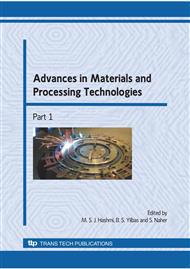p.563
p.571
p.579
p.592
p.601
p.611
p.616
p.622
p.630
Metallurgical and Numerical Correlation of Mold Vibration with the Refinement of Al-Si Alloy
Abstract:
Applying mechanical vibration with subsonic frequencies during permanent mold casting enhances nucleation and improves mold-casting heat transfer. Despite the several published papers in this field, little attention was given to correlating the vibration parameters of frequency and amplitude with the casting microstructure. In this paper microstructure examination and numerical simulation are used to explain the microstructure refinement using mold-vibration. A 1-D numerical model is used to explain the different mechanisms that mold-vibration has at different frequencies of 100 Hz, 500 Hz, and 2000 Hz. Microstructure examination for samples of Al-12.6wt%Si are presented and a correlation with the numerical results using inverse heat conduction method is attempted. Results show that increasing the value of the apparent thermal diffusivity of the casting is as a result of vibration is a major factor in achieving the desired refinement. Improving the mold-casting heat transfer coefficient showed significant influence on the process only at high frequency of 2 kHz due to the low vibration amplitude used.
Info:
Periodical:
Pages:
601-610
Citation:
Online since:
December 2009
Authors:
Price:
Сopyright:
© 2010 Trans Tech Publications Ltd. All Rights Reserved
Share:
Citation:


